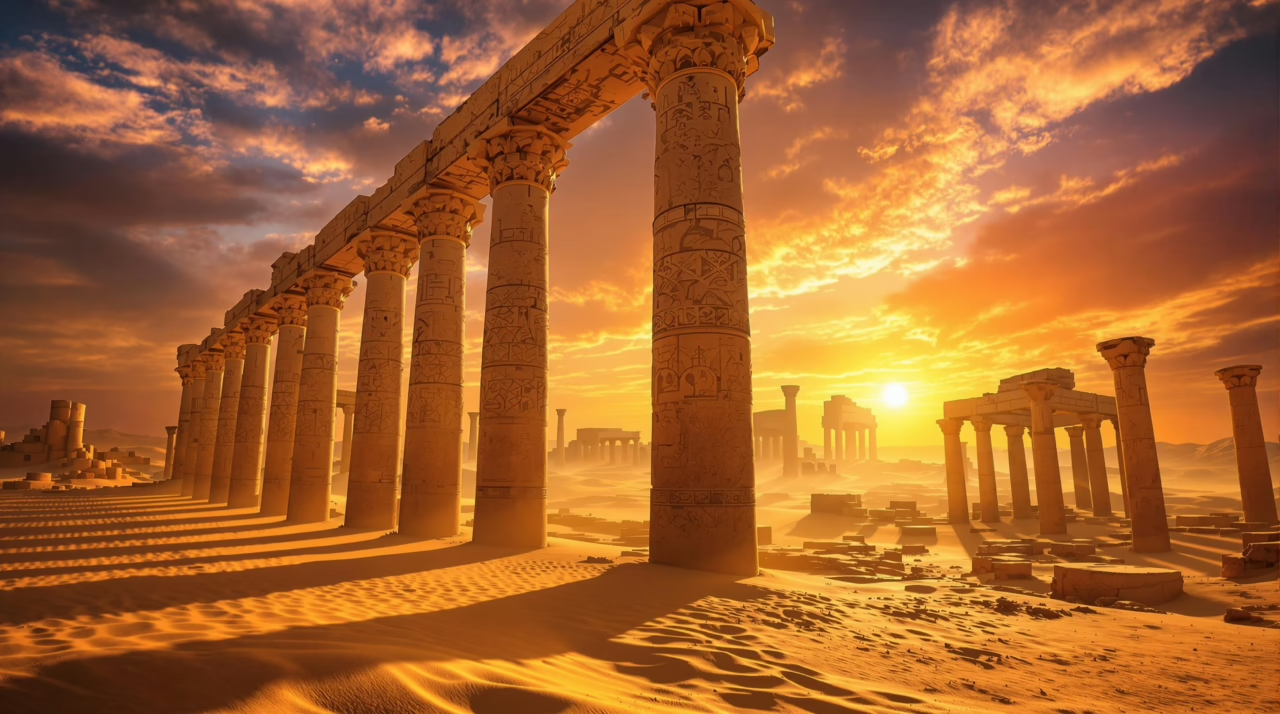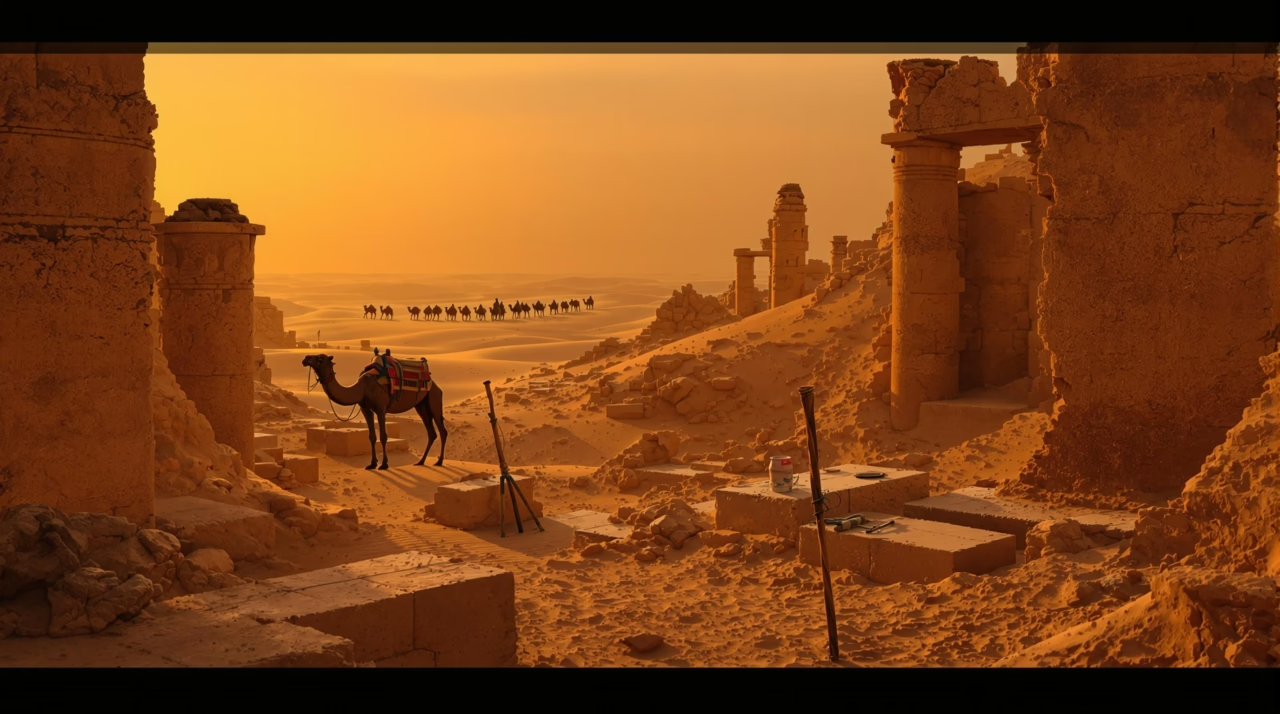Iram of the Pillars: Arabia’s Atlantis

Iram of the Pillars stands as a compelling enigma within the annals of ancient lore.
Its portrayal in religious texts intertwines with the narrative of a mighty civilization that succumbed to its own hubris.
The search for Iram’s true location raises questions about historical accuracy and the nature of myth.
As archaeological endeavors reveal tantalizing clues, one must ponder: what lies beneath the sands, and how does it challenge our understanding of history?
Summary & Key Takeaways
Hide- Iram, known as the "City of Pillars," symbolizes both a lost civilization and moral lessons about hubris and accountability.
- The Rub' al Khali has been proposed as Iram's potential location, linking it to legendary sites like Ubar and Shisur.
- Archaeological evidence, including intricate structures and artifacts, suggests a thriving civilization, though debates about its identity continue among scholars.
- The Composite Myth Theory indicates that Iram's story is shaped by multiple civilizations, blending historical and mythical elements.
- Advances in technology, such as satellite imagery and ground-penetrating radar, are reshaping the search for Iram and its place in history.
The Legend of Iram in Ancient Texts

The legend of Iram, often associated with the enigmatic “City of Pillars,” is particularly referenced in the Quran, where it serves as a cautionary tale of hubris and divine retribution.
This ancient texts narrative also captured the attention of early Western scholars, who sought to reconcile its mythic elements with historical reality.
Such cross-cultural engagements raise intriguing questions about the origins and evolution of the Iram myth across diverse civilizations.
Mentions in the Quran and Islamic Tradition
The references to Iram in the Quran, particularly within Surah Al-Fajr, invite exploration of the fate of the People of ‘Ad, who were said to have flourished in a mighty civilization before facing divine retribution.
This connection raises questions about the symbolic significance of Iram as both a physical place and a moral lesson about hubris and consequence.
How does this narrative reflect broader themes within Islamic tradition, and what implications does it hold for understanding the intersection of myth and history?
The People of ‘Ad and Their Punishment

Although often shrouded in myth, the story of the People of ‘Ad serves as a poignant reminder of the consequences of hubris and disobedience, as chronicled in various ancient texts including the Quran.
Their arrogance led to a divine retribution, manifested through a devastating windstorm, prompting reflection on the fragility of power and the moral imperatives that govern human existence in pursuit of freedom.
Surah Al-Fajr and the Reference to Iram
Surah Al-Fajr serves as a poignant reminder of divine accountability, weaving the tale of Iram—a city lost to time—into its verses.
This reference prompts reflection on the consequences of hubris and disobedience. Scholars question the historical significance of Iram, exploring its implications within Islamic tradition.
Such inquiries invite a broader understanding of morality, legacy, and the enduring quest for truth in human history.
Early Western Awareness of the Myth
The legend of Iram of the Pillars captured the attention of European Orientalists, who sought to reconcile this enigmatic tale with existing Biblical and classical narratives.
By examining the intersections of these texts, scholars uncovered intriguing parallels that shaped early Western understanding of the myth.
This engagement not only illuminated Iram’s significance but also reflected broader cultural exchanges between East and West.
Influence of European Orientalists
As European scholars began exploring the intricate fabric of Eastern lore, the legend of Iram emerged as a fascinating subject, revealing the allure of ancient myths that transcended cultures.
These Orientalists, captivated by Iram’s enigmatic nature, meticulously dissected ancient texts, weaving together historical and literary threads. Their interpretations sparked curiosity and debate, ultimately enriching the Western understanding of the vibrant mosaic of Eastern mythology.
Parallels with Biblical and Classical Sources
While delving into the legend of Iram, scholars have unearthed intriguing parallels with both Biblical and classical sources, revealing a complex interplay of cultural narratives.
Key connections include:
- The lost city motif in ancient texts.
- Descriptions of divine retribution.
- Comparisons with the fabled Atlantis.
- Shared themes of moral decline and societal collapse.
These elements enrich our understanding of Iram’s legacy.
Where Was Iram Supposed to Be?
The location of Iram of the Pillars has long intrigued scholars and historians, sparking a variety of theories regarding its geographical positioning.
By examining ancient trade routes, one can uncover potential clues that may lead to a more accurate understanding of this elusive city.
What do these historical pathways reveal about the culture and commerce that might have once thrived within Iram’s fabled walls?
Theories About Its Location
The search for Iram of the Pillars has generated intriguing hypotheses regarding its possible location, particularly the Rub’ al Khali, or Empty Quarter.
Scholars have drawn compelling connections between this elusive city and other legendary sites such as Ubar and Shisur, prompting questions about their interrelations.
As speculation continues, the geographical and cultural implications of these theories invite further exploration into the historical significance of Iram.
Rub’ al Khali (Empty Quarter) Hypothesis
Numerous scholars have proposed the Rub’ al Khali, or Empty Quarter, as a potential location for the lost city of Iram of the Pillars, igniting a fascinating debate about its historical and geographical significance.
Key considerations include:
- Vast, uncharted terrain
- Ancient trade routes
- Archaeological anomalies
- Cultural references in texts
This hypothesis encourages an exploration of the desert’s enigmatic past.
Connections to Ubar and Shisur
While many scholars have sought to pinpoint the location of Iram of the Pillars, connections to the ancient cities of Ubar and Shisur reveal intriguing possibilities that merit further investigation.
Both cities are steeped in myth and legend, suggesting a vibrant mosaic of cultural heritage. Evaluating their geographical and historical contexts may illuminate the elusive whereabouts of Iram, inviting exploration into a timeless enigma.
Clues from Ancient Trade Routes
The intricate web of ancient trade routes, particularly the renowned frankincense trails, presents significant insights into the potential location of Iram of the Pillars.
By examining the caravan networks that linked various lost cities along the desert’s edge, one can begin to piece together the geographical context that may have surrounded this fabled city.
These routes not only facilitated commerce but also shaped cultural exchanges, raising questions about Iram’s role in the broader tapestry of ancient trade.
Frankincense Trails and Caravan Networks
As ancient trade routes crisscrossed the Arabian Peninsula, the significance of frankincense became increasingly apparent, serving not only as a valuable commodity but also as a marker of cultural exchange.
The caravan networks facilitated:
- Economic prosperity
- Cultural diffusion
- Diplomatic relations
- Spiritual connections
These elements collectively shaped the mystique surrounding Iram, suggesting its potential location along these essential pathways of trade and interaction.
Lost Cities Along the Desert Edge
Where might one find the remnants of Iram, the fabled city shrouded in mystery?
Scholars speculate its location along ancient trade routes, where lost cities flourished at the desert’s edge. These pathways, once lively with commerce, provide tantalizing clues.
As explorers retrace these lines, questions arise—could Iram lie hidden among the sands, waiting to reveal its secrets for those daring enough to seek?
The 1992 Discovery: City Beneath the Sands
In 1992, the advent of satellite imaging revealed a potentially significant archaeological site beneath the sands, sparking interest and debate among scholars.
This discovery raised questions about its identification as Iram of the Pillars, a city shrouded in legend.
Analyzing the evidence from the expedition invites a critical examination of the intersection between technology and historical accuracy in understanding ancient civilizations.
Satellite Imaging and the Expedition
The advent of satellite imaging and remote sensing technology, spearheaded by NASA, marked a pivotal moment in the search for Iram of the Pillars.
Researchers’ exploration of the Shisur region revealed intriguing anomalies that hinted at the remnants of a long-lost city beneath the sands.
This discovery not only raised questions about the methods utilized but also about the historical narratives surrounding ancient urban settlements.
Role of NASA and Remote Sensing Technology
Frequently overlooked in discussions of archaeological discovery, the role of NASA and remote sensing technology has proven pivotal in revealing ancient urban landscapes, such as the fabled Iram of the Pillars.
Key contributions included:
- High-resolution satellite imagery.
- Infrared detection of subsurface structures.
- Geographic Information Systems (GIS) for mapping.
- Data integration enhancing archaeological strategies.
These advancements have transformed our understanding of lost civilizations.
What Researchers Found at Shisur
Amidst the shifting sands of time, the 1992 discovery at Shisur revealed a city long buried beneath layers of earth, igniting intrigue in the archaeological community.
Researchers, utilizing advanced satellite imaging, uncovered intricate remnants of structures and artifacts that hinted at a once-thriving civilization.
This finding raised profound questions about the region’s history, culture, and the potential connections to the legendary Iram of the Pillars.
Was It Really Iram?
The 1992 discovery beneath the sands raised compelling questions about the identity of the ancient city, sparking intense debate among archaeologists and historians.
While some interpret the findings as definitive evidence of Iram, others approach the data with skepticism, urging caution in claims that may overstate the archaeological significance.
This tension between evidence and interpretation invites further exploration into the complexities surrounding the legendary city and its elusive historical context.
Archaeological Evidence and Interpretations
Numerous archaeological endeavors have sought to uncover the truth behind the legendary Iram of the Pillars, particularly following the 1992 discovery of a vast city buried beneath the sands of Oman.
Key findings include:
- Intricate column structures
- Advanced irrigation systems
- Pottery with ancient inscriptions
- Evidence of trade networks
These elements fuel ongoing debates about the city’s identity and its connection to the mythical Iram.
Skepticism from Scholars and Historians
Skepticism looms over the 1992 discovery of a buried city in Oman, as scholars and historians grapple with the evidence presented.
Critics question the identification of the site as Iram, citing a lack of definitive artifacts and inconsistencies in the archaeological narrative.
This uncertainty invites a deeper inquiry into the intersection of myth and reality, challenging the quest for truth in ancient histories.
Architecture and the ‘Pillars
The architectural significance of Iram’s pillars invites a deeper understanding of the city’s material culture and its socio-political context.
Scholars interpret the descriptions of these pillars not merely as structural elements, but as symbols reflecting the values and beliefs of the civilization that constructed them.
This inquiry raises questions about the interplay between form and function, and how such architectural features might encapsulate the essence of a society lost to time.
Interpretations of the Pillared Descriptions
The architectural descriptions of Iram’s pillars provoke a critical examination of whether these elements represent monumental structures or merely towering myths embedded in Arabian folklore.
By comparing Iram to other ancient Arabian settlements, one can uncover potential cultural and historical influences that shape these interpretations.
Such an inquiry raises essential questions about the nature of architectural representation and its interplay with myth in the region’s collective memory.
Monumental Structures or Towering Myths?
How can one differentiate between the architectural marvels of a lost civilization and the embellished tales of myth? Scholars often analyze:
- Historical texts and oral traditions
- Archaeological evidence and ruins
- Cultural symbolism and significance
- Geographical context and feasibility
These elements illuminate the debate, prompting questions about the nature of Iram.
Are its pillars a reflection of human ambition or mere figments of imagination?
Comparison to Other Arabian Settlements
Architectural similarities and differences among ancient Arabian settlements provide a compelling framework for understanding the enigmatic descriptions of Iram’s pillars.
Notable structures, such as the mud-brick edifices of Al-Ula and the intricate stonework of Petra, invite comparisons.
These variations prompt inquiries into cultural exchanges and environmental adaptations, revealing how the mythic Iram might echo the architectural ingenuity of its contemporaries, while transcending mere physicality.
Material Culture of the Region
The material culture of Iram, particularly its architecture and the enigmatic pillars, raises intriguing questions about the society that once thrived there.
The presence of artifacts, ceramics, and sophisticated well systems points to a complex civilization, yet the absence of inscriptions only deepens the mystery surrounding its inhabitants.
This lack of written documentation invites speculation about the cultural practices and beliefs that shaped their architectural choices and daily life.
Artifacts, Ceramics, and Well Systems
While exploring the remnants of Iram of the Pillars, one cannot overlook the significance of artifacts, ceramics, and well systems as essential indicators of the region’s material culture.
These findings reveal:
- Trade connections through ceramic styles.
- Domestic life reflected in artifact diversity.
- Advanced engineering of well systems for water access.
- Cultural practices inferred from decorative motifs.
Such elements evoke a profound understanding of this vanished civilization.
Lack of Inscriptions and the Mystery It Creates
Artifacts and well systems offer a glimpse into the daily lives of the inhabitants of Iram of the Pillars, yet a striking absence of inscriptions raises intriguing questions about their society.
This lack of written records prompts speculation about their communication methods, cultural values, and historical continuity.
Were they a society that prioritized oral traditions, or does this void conceal deeper enigmas waiting to be unraveled?
Myth vs History: Separating Story from Structure
The narrative of Iram of the Pillars blurs the lines between myth and historical fact, inviting scrutiny of its role as a symbol in various religious texts.
Scholars ponder whether this legendary city represents a singular lost civilization or if it is an amalgamation of multiple cultures and locations.
As the search for Iram continues, the quest to distinguish between the mythological and the historical becomes increasingly complex.
Iram as a Symbol in Religious Literature
Iram of the Pillars serves as a poignant symbol in religious literature, encapsulating the themes of arrogance and the inevitable decline that accompanies hubris.
Within Islamic eschatology, the narrative of Iram invites reflection on the moral lessons embedded in its mythological structure, prompting a critical examination of historical truths versus allegorical interpretations.
This juxtaposition raises intriguing questions about the lessons society draws from such stories and their relevance to contemporary moral frameworks.
Warnings of Arrogance and Decline
How does the tale of Iram of the Pillars resonate with contemporary warnings against arrogance and societal decline?
This narrative serves as a cautionary reflection on:
- The fragility of success.
- The consequences of hubris.
- The inevitability of moral decay.
- The importance of humility in leadership.
Iram’s story, a blend of myth and history, invites introspection on our current societal trajectories.
Its Role in Islamic Eschatology
While many narratives intertwine myth and reality, the story of Iram of the Pillars occupies a unique position within Islamic eschatology, serving as both a historical allegory and a profound symbol.
This enigmatic city embodies the consequences of hubris, prompting reflections on moral decline.
As a cautionary tale, Iram challenges believers to contemplate their own paths amidst the tapestry of faith and destiny.
Possibility of Multiple Lost Cities
The concept of Iram, often intertwined with the legend of Ubar, raises intriguing questions about the existence of multiple lost cities within the tapestry of myth and history.
The Composite Myth Theory suggests that these narratives may represent fragmented memories of various ancient locales, each contributing to the elusive idea of a singular, magnificent city.
As historians sift through the mirage of memory, the challenge lies in distinguishing between these storied constructs and the concrete remnants of civilization.
Composite Myth Theory
Although the legends surrounding Iram of the Pillars evoke a singular image of a lost city, they may actually represent a composite myth, blending various historical narratives and cultural memories.
This theory suggests:
- Multiple civilizations contributed to the myth.
- Each narrative reflects distinct cultural values.
- The stories may intertwine real and imagined elements.
- Iram’s identity may shift across time and place, highlighting a broader human experience.
Ubar, Iram, and the Mirage of Memory
Ubar and Iram, often intertwined in the tapestry of ancient lore, serve as compelling case studies in the exploration of myth versus history.
Their stories evoke questions about the nature of memory and the human inclination to romanticize the past.
The possibility of multiple lost cities blurs the lines between fact and fiction, inviting a deeper inquiry into the collective yearning for vanished civilizations.
Why the Legend Persists
The enduring allure of Iram of the Pillars can be attributed to humanity’s intrinsic fascination with lost civilizations, which stirs both wonder and curiosity.
Coupled with ongoing research and exploration, this legend has become a canvas for imagination, inviting scholars and adventurers alike to piece together its fragmented history.
As new discoveries emerge, the narrative of Iram continues to evolve, fueling a relentless quest for understanding the mysteries of the past.
Fascination with Vanished Civilizations
The enduring allure of Iram of the Pillars as a “Desert Atlantis” highlights humanity’s fascination with civilizations that have mysteriously vanished.
This intrigue is mirrored in literature and popular culture, where echoes of lost worlds inspire narratives that blend myth and reality.
Such stories invite reflection on the fragility of human achievement and the impermanence of cultural legacies.
Cultural Power of a Desert Atlantis
While tales of lost civilizations often capture the human imagination, few legends resonate as profoundly as that of Iram of the Pillars, a mythical city believed to have vanished beneath the sands of the Arabian Desert.
This enduring fascination arises from:
- The allure of mystery
- Symbolism of lost potential
- Reflection of human transience
- Desire for exploration and discovery
Such elements keep Iram’s legend alive.
Echoes in Literature and Popular Culture
Legends like Iram of the Pillars resonate through literature and popular culture, capturing the imagination of audiences across generations.
This enduring fascination with vanished civilizations reflects humanity’s longing for mystery and the unknown.
Authors and creators weave tales of lost worlds, prompting questions about existence, legacy, and the fragility of human achievement, igniting a desire to explore what remains hidden beneath the sands of time.
Ongoing Research and Exploration
Ongoing research into Iram of the Pillars is increasingly influenced by advanced technologies that challenge previous assumptions about its existence and location.
Simultaneously, local traditions and oral histories serve as essential conduits, perpetuating the legend and enriching its narrative.
This intersection of innovation and cultural memory raises compelling questions about the enduring allure of lost civilizations.
New Technologies Reopening Old Questions
As archaeological and technological advancements continue to unfold, the legend of Iram of the Pillars remains a fascinating enigma that challenges scholars and explorers alike.
Recent developments have prompted renewed interest in Iram through:
- Ground-penetrating radar
- Satellite imagery
- Geographical information systems (GIS)
- Digital modeling
These tools reveal ancient landscapes, fostering questions about the civilization’s existence and its enduring legacy.
Local Traditions Keeping the Story Alive
While the allure of Iram of the Pillars captivates modern scholars, it is the local traditions that breathe life into the legend, ensuring its survival through generations.
Oral histories, folklore, and regional rituals interweave with archaeological pursuits, creating a tapestry of collective memory.
This ongoing cultural engagement not only preserves the myth but also invites inquiry into its deeper significance within the community’s identity.
Wrapping Up
The tale of Iram of the Pillars lingers like an echo of a sunken city, a poignant reminder of humanity’s perennial struggle against hubris.
As scholars explore deeper into its layered history, they unearth not only remnants of a lost civilization but also reflections of our own follies.
Like Atlantis, Iram invites us to ponder the fragility of greatness, urging a reevaluation of our aspirations as we navigate the sands of time, forever searching for what might have been.





